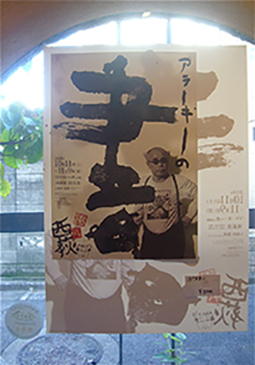 |
|
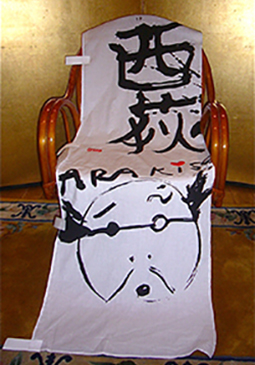 |
|
|
|
Nobuyoshi Araki in a poster for his Nishiogi calligraphy exhibition, mounted on a window at Gallery Juan. |
|
"Nishiogi," calligraphy and self-portrait by Araki, at Gallery Juan. |
The neighborhood around Nishiogikubo station, on the Chuo Line about 15 minutes west of Shinjuku, has long been a hangout for artists, writers, and other bohemian types. In my nearly 14 years of residence here, the variety of small privately-owned businesses (nary a Starbucks in sight) and do-it-yourself cultural events within walking distance have always ensured that there is never a dull moment.
Lately, arts-related activities in this town seem to have acquired a true critical mass, turning Nishiogi into a real -- though still under-the-radar by Tokyo standards -- mecca for creative endeavors, spanning the spectrum from head-scratching to sublime. This month alone promises such a plethora of events that it's hard to keep track, let alone mention them all in one article. Let me introduce a few, as well as some of the local movers and shakers who have made Nishiogi such a funkily happenin' place.
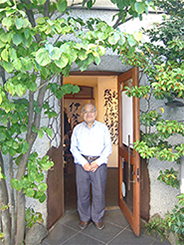 |
|
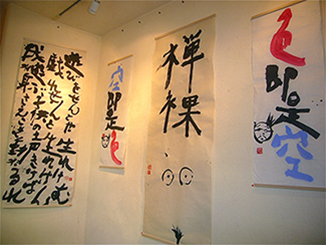 |
|
|
|
Iseya proprietor Tokuju Inohana at the entrance to Gallery Juan, with Araki's calligraphy visible inside. |
|
Some examples of Araki's calligraphy. The piece in the middle reads "Zen Nude." |
The shopping streets to the north and west of the station are a favorite destination of antique shoppers. One of the most venerable dealers is Iseya, which handles everything from works of art to kimono and tea-ceremony utensils. For the past 12 years Iseya has also operated Gallery Juan, an eminently tasteful exhibit space that resembles a tea house.
As chair of the Nishiogikubo Shopowners Association, Iseya proprietor Tokuju Inohana enjoys considerable local clout, which he exercised recently to produce a multi-venue art exhibition that currently fills a dozen shops and galleries throughout the district. Araki's Calligraphy in Nishiogi showcases the heretofore hidden brush-wielding talents of photographer Nobuyoshi Araki, best known for his maverick oeuvre of nude shots, Tokyo cityscapes, and cat portraits.
Inohana says he met Araki by chance in a Shinjuku jazz bar, and learned that the photographer was fond of the Nishiogi neighborhood. He was also taken with an example he saw of Araki's calligraphy on a nearby store sign. Out of this evolved an ambitious plan to display his brushwork not only at Juan but in venues all over Nishiogi, an idea to which the artist, and Inohana's local contacts, quickly agreed. Inohana gave him 300 sheets of washi paper, and in short order Araki produced 150 works that grace the 'hood until November 9. Executed in a charmingly loosey-goosey scrawl, the texts are proverb-like quips (perhaps thought up on the spot) about life and art -- some thoughtful, many amusing or (as one would expect of Araki) puckishly provocative. Though they won't win any calligraphy prizes, Araki's jottings dramatically transform the diverse settings they occupy.
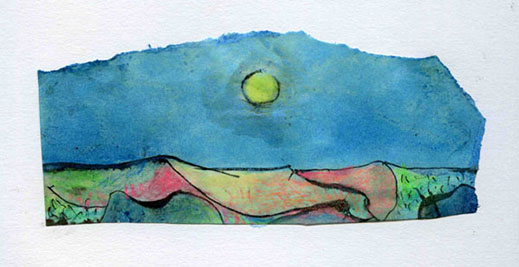 |
|
| Landscape (2014) by Makoto Umeno, watercolor, crayon and ink on torn paper, heated on iron plate; on display at Hakkyaro Gallery, Hobbit Mura. Courtesy of the artist. |
Though it's hard to pinpoint when and how Nishiogi acquired its countercultural cachet, the opening of Hobbit Mura (Hobbit Village) in 1976 was a significant point of departure. An alternative shopping center of sorts occupying a narrow, ivy-covered building just south of the station, it contains Japan's first organic grocery store, a natural-foods café, an alternative bookstore, and the Hobbit Mura School, a space devoted to a full calendar of classes, workshops, and performances.
From November 14 to December 7, the Nawa Prasad bookstore's Hakkyaro Gallery will feature a collaborative installation, Fragments of Space, by the innovative mixed-media artist Makoto Umeno and the charismatic poet Izumi Umeno, with a poetry reading scheduled for November 29.
Close by Zenpukuji Park, a 20-minute walk north of the station, sits another institution that has become an anchor of the local art scene since it opened in 2002. Hiroko and Tatsuhiko Murata converted a former TB sanatorium into Youkobo Art Space, a complex that boasts not only a gallery but studios and living quarters for a constantly revolving roster of artists-in-residence, many from overseas. Youkobo also founded Trolls in the Park, the hugely successful outdoor art exhibition in Zenpukuji every November. This year's edition offers 31 artists and performers, many of whom have seized the opportunity to incorporate elements of the natural environment around Zenpukuji Pond into their installations.
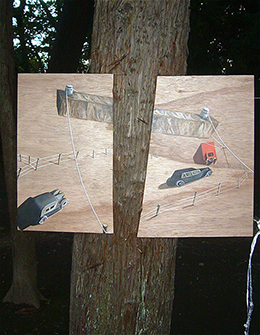 |
|
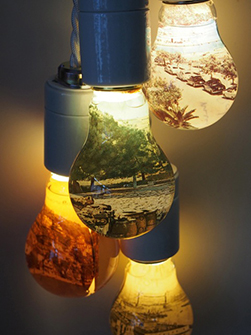 |
|
|
|
"Death on the Ridge Road" after Grant Wood, acrylic and wood, part of Playtime by Maya Lama, on display at Trolls in the Park 2014. |
|
Kaoru Murakami, Bulb Cities (2014), used postcards and light bulbs, on display at Youkobo Art Space. Courtesy of the artist. |
A good example is the work of Nepali-Japanese artist Maya Lama, whose exhibition Playtime series uses the trees by the pond not only as a backdrop for her paintings, but as part of the works themselves. Her interpretation of Grant Wood's Death on the Ridge Road (1935), for instance, builds the acrylic-on-board composition around a tree trunk that doubles as the cross-like telegraph pole that is the painting's central motif.
Concurrently with the Trolls event, Youkobo's indoor gallery is hosting Kaoru Murakami's Bulb Cities, which combines used picture postcards and light bulbs collected from strangers in a novel installation that confronts "the dangers of forgetting and remembering in the recreation of reality."
Adding to the fun in Nishiogi this month is a new event, Art Drops, which aspires to link the station area with venues in Zenpukuji to the north. Working closely with Trolls in the Park, the folks at Art Drops have organized displays of street art in storefronts all over the neighborhood under the rubric of "Trolls Out On the Town," as well as a series of parades and performances.
There are few shopping districts left in Tokyo as refreshingly unspoiled by chainstore sameness as Nishiogi, and few parks as lovely -- and relatively uncrowded -- as Zenpukuji in autumn. It's the perfect season to take a day off to stroll around and savor the often quirky, and occasionally mind-boggling, delights of this little corner of the metropolis.
|
| Some "trolls on the town" in front of a gallery in Nishiogi, part of a street-art exhibition organized by Art Drops. |
|
|
All photos by Alan Gleason unless otherwise indicated.
|
|